Advanced Construction Management: Waste Management Report
VerifiedAdded on 2022/09/16
|7
|1383
|18
Report
AI Summary
This report delves into the critical factors influencing waste management plans during the demolition and construction phases of facilities. It highlights the importance of procedures, health assurances, and economic incentives in promoting effective waste management. The report analyzes two case studies: a mass transit project in Bangkok and a government university building in Thailand, illustrating the impact of local regulations and operator attitudes on waste management practices. It also provides recommendations for minimizing waste, including just-in-time material deliveries, proper storage, and the reduction of excess packaging. The report emphasizes the significance of waste reduction as the most cost-effective solution and encourages strategies to prevent waste generation on construction sites. References to relevant research papers are also included.
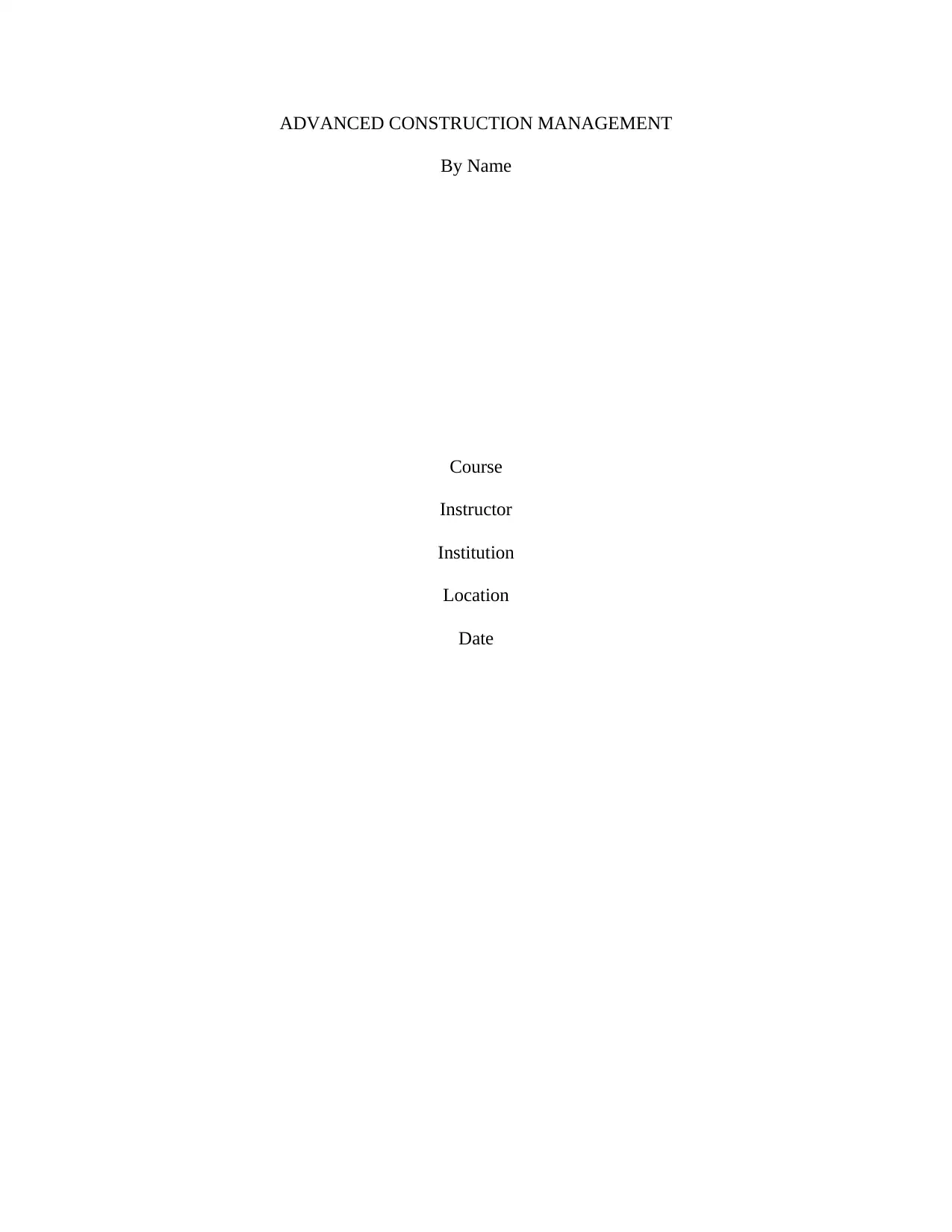
ADVANCED CONSTRUCTION MANAGEMENT
By Name
Course
Instructor
Institution
Location
Date
By Name
Course
Instructor
Institution
Location
Date
Paraphrase This Document
Need a fresh take? Get an instant paraphrase of this document with our AI Paraphraser
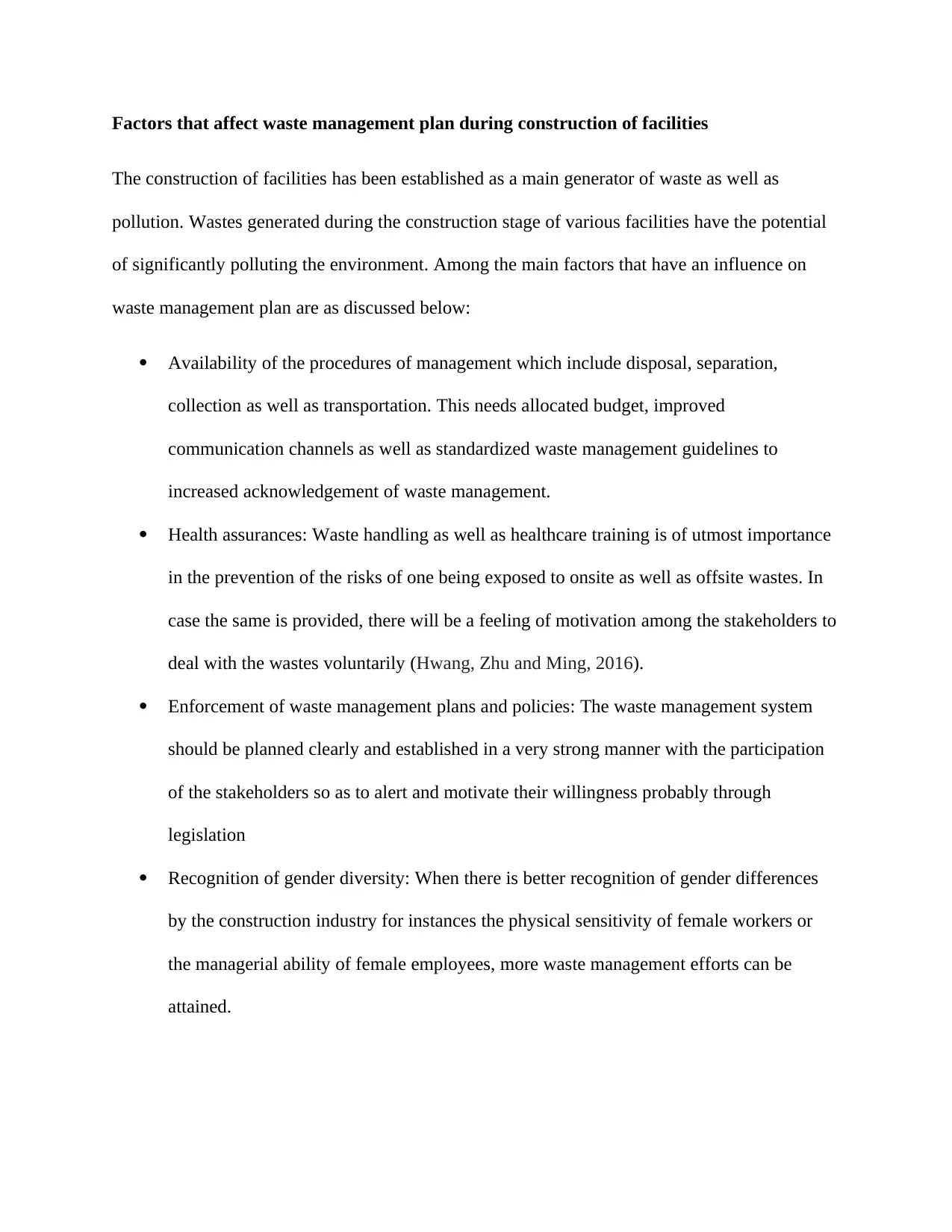
Factors that affect waste management plan during construction of facilities
The construction of facilities has been established as a main generator of waste as well as
pollution. Wastes generated during the construction stage of various facilities have the potential
of significantly polluting the environment. Among the main factors that have an influence on
waste management plan are as discussed below:
Availability of the procedures of management which include disposal, separation,
collection as well as transportation. This needs allocated budget, improved
communication channels as well as standardized waste management guidelines to
increased acknowledgement of waste management.
Health assurances: Waste handling as well as healthcare training is of utmost importance
in the prevention of the risks of one being exposed to onsite as well as offsite wastes. In
case the same is provided, there will be a feeling of motivation among the stakeholders to
deal with the wastes voluntarily (Hwang, Zhu and Ming, 2016).
Enforcement of waste management plans and policies: The waste management system
should be planned clearly and established in a very strong manner with the participation
of the stakeholders so as to alert and motivate their willingness probably through
legislation
Recognition of gender diversity: When there is better recognition of gender differences
by the construction industry for instances the physical sensitivity of female workers or
the managerial ability of female employees, more waste management efforts can be
attained.
The construction of facilities has been established as a main generator of waste as well as
pollution. Wastes generated during the construction stage of various facilities have the potential
of significantly polluting the environment. Among the main factors that have an influence on
waste management plan are as discussed below:
Availability of the procedures of management which include disposal, separation,
collection as well as transportation. This needs allocated budget, improved
communication channels as well as standardized waste management guidelines to
increased acknowledgement of waste management.
Health assurances: Waste handling as well as healthcare training is of utmost importance
in the prevention of the risks of one being exposed to onsite as well as offsite wastes. In
case the same is provided, there will be a feeling of motivation among the stakeholders to
deal with the wastes voluntarily (Hwang, Zhu and Ming, 2016).
Enforcement of waste management plans and policies: The waste management system
should be planned clearly and established in a very strong manner with the participation
of the stakeholders so as to alert and motivate their willingness probably through
legislation
Recognition of gender diversity: When there is better recognition of gender differences
by the construction industry for instances the physical sensitivity of female workers or
the managerial ability of female employees, more waste management efforts can be
attained.
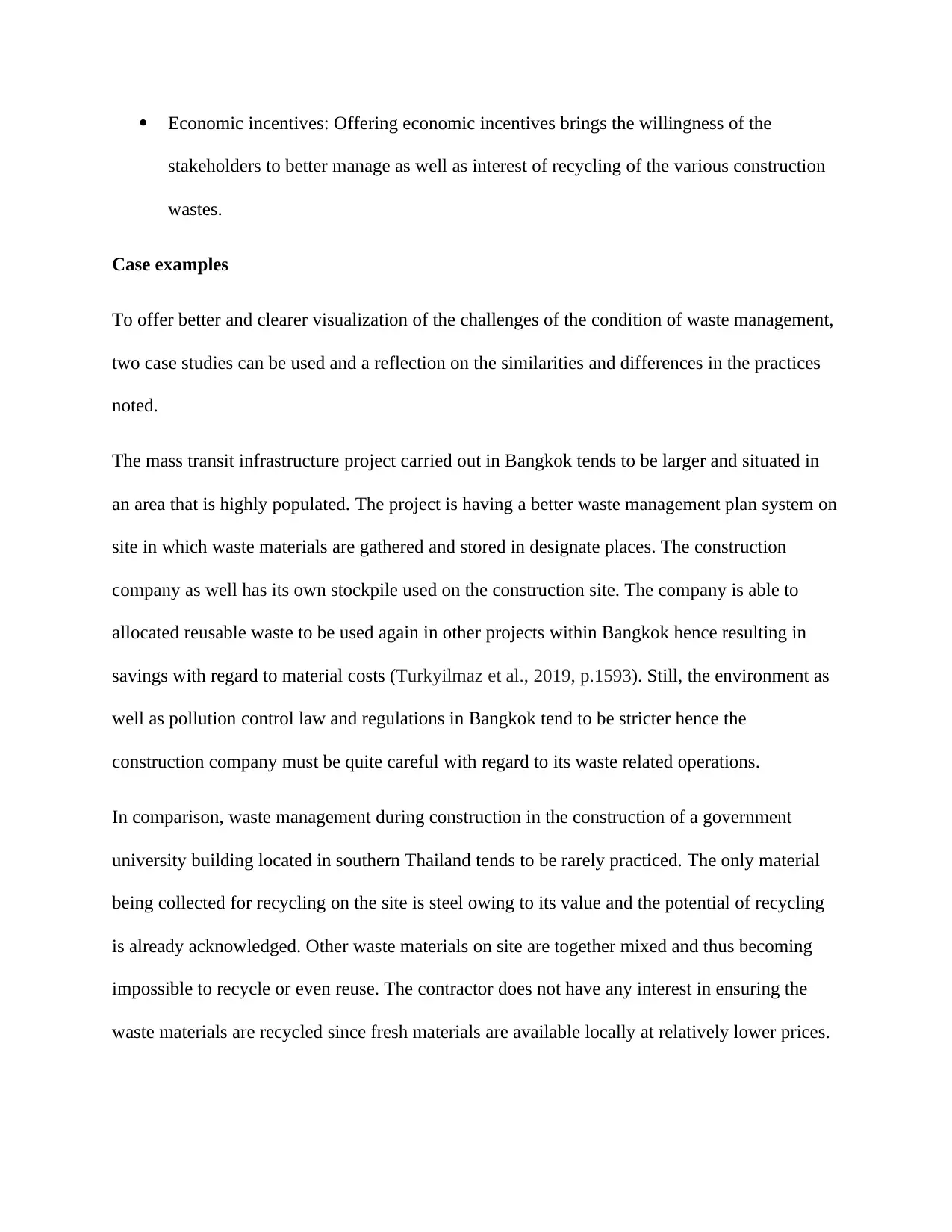
Economic incentives: Offering economic incentives brings the willingness of the
stakeholders to better manage as well as interest of recycling of the various construction
wastes.
Case examples
To offer better and clearer visualization of the challenges of the condition of waste management,
two case studies can be used and a reflection on the similarities and differences in the practices
noted.
The mass transit infrastructure project carried out in Bangkok tends to be larger and situated in
an area that is highly populated. The project is having a better waste management plan system on
site in which waste materials are gathered and stored in designate places. The construction
company as well has its own stockpile used on the construction site. The company is able to
allocated reusable waste to be used again in other projects within Bangkok hence resulting in
savings with regard to material costs (Turkyilmaz et al., 2019, p.1593). Still, the environment as
well as pollution control law and regulations in Bangkok tend to be stricter hence the
construction company must be quite careful with regard to its waste related operations.
In comparison, waste management during construction in the construction of a government
university building located in southern Thailand tends to be rarely practiced. The only material
being collected for recycling on the site is steel owing to its value and the potential of recycling
is already acknowledged. Other waste materials on site are together mixed and thus becoming
impossible to recycle or even reuse. The contractor does not have any interest in ensuring the
waste materials are recycled since fresh materials are available locally at relatively lower prices.
stakeholders to better manage as well as interest of recycling of the various construction
wastes.
Case examples
To offer better and clearer visualization of the challenges of the condition of waste management,
two case studies can be used and a reflection on the similarities and differences in the practices
noted.
The mass transit infrastructure project carried out in Bangkok tends to be larger and situated in
an area that is highly populated. The project is having a better waste management plan system on
site in which waste materials are gathered and stored in designate places. The construction
company as well has its own stockpile used on the construction site. The company is able to
allocated reusable waste to be used again in other projects within Bangkok hence resulting in
savings with regard to material costs (Turkyilmaz et al., 2019, p.1593). Still, the environment as
well as pollution control law and regulations in Bangkok tend to be stricter hence the
construction company must be quite careful with regard to its waste related operations.
In comparison, waste management during construction in the construction of a government
university building located in southern Thailand tends to be rarely practiced. The only material
being collected for recycling on the site is steel owing to its value and the potential of recycling
is already acknowledged. Other waste materials on site are together mixed and thus becoming
impossible to recycle or even reuse. The contractor does not have any interest in ensuring the
waste materials are recycled since fresh materials are available locally at relatively lower prices.
⊘ This is a preview!⊘
Do you want full access?
Subscribe today to unlock all pages.

Trusted by 1+ million students worldwide
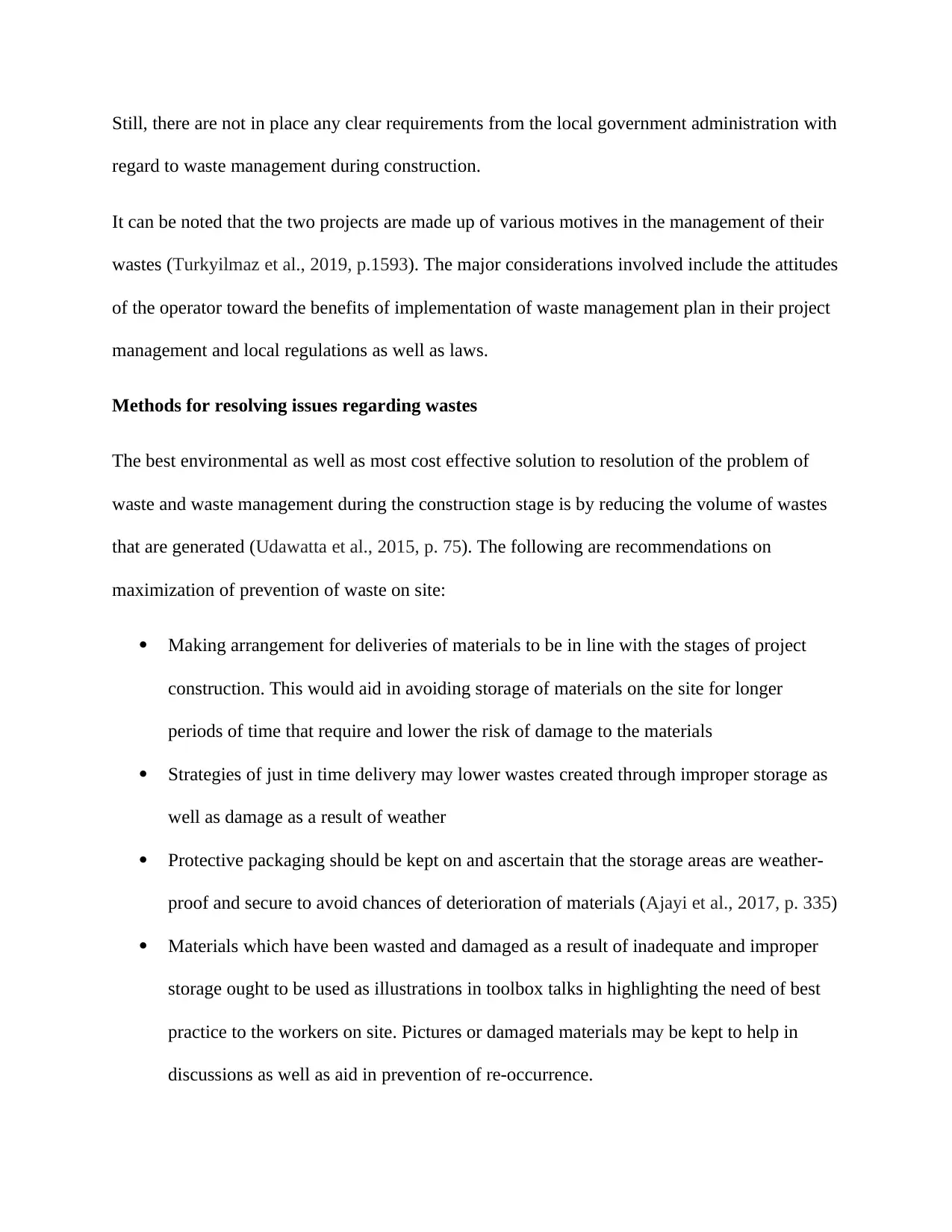
Still, there are not in place any clear requirements from the local government administration with
regard to waste management during construction.
It can be noted that the two projects are made up of various motives in the management of their
wastes (Turkyilmaz et al., 2019, p.1593). The major considerations involved include the attitudes
of the operator toward the benefits of implementation of waste management plan in their project
management and local regulations as well as laws.
Methods for resolving issues regarding wastes
The best environmental as well as most cost effective solution to resolution of the problem of
waste and waste management during the construction stage is by reducing the volume of wastes
that are generated (Udawatta et al., 2015, p. 75). The following are recommendations on
maximization of prevention of waste on site:
Making arrangement for deliveries of materials to be in line with the stages of project
construction. This would aid in avoiding storage of materials on the site for longer
periods of time that require and lower the risk of damage to the materials
Strategies of just in time delivery may lower wastes created through improper storage as
well as damage as a result of weather
Protective packaging should be kept on and ascertain that the storage areas are weather-
proof and secure to avoid chances of deterioration of materials (Ajayi et al., 2017, p. 335)
Materials which have been wasted and damaged as a result of inadequate and improper
storage ought to be used as illustrations in toolbox talks in highlighting the need of best
practice to the workers on site. Pictures or damaged materials may be kept to help in
discussions as well as aid in prevention of re-occurrence.
regard to waste management during construction.
It can be noted that the two projects are made up of various motives in the management of their
wastes (Turkyilmaz et al., 2019, p.1593). The major considerations involved include the attitudes
of the operator toward the benefits of implementation of waste management plan in their project
management and local regulations as well as laws.
Methods for resolving issues regarding wastes
The best environmental as well as most cost effective solution to resolution of the problem of
waste and waste management during the construction stage is by reducing the volume of wastes
that are generated (Udawatta et al., 2015, p. 75). The following are recommendations on
maximization of prevention of waste on site:
Making arrangement for deliveries of materials to be in line with the stages of project
construction. This would aid in avoiding storage of materials on the site for longer
periods of time that require and lower the risk of damage to the materials
Strategies of just in time delivery may lower wastes created through improper storage as
well as damage as a result of weather
Protective packaging should be kept on and ascertain that the storage areas are weather-
proof and secure to avoid chances of deterioration of materials (Ajayi et al., 2017, p. 335)
Materials which have been wasted and damaged as a result of inadequate and improper
storage ought to be used as illustrations in toolbox talks in highlighting the need of best
practice to the workers on site. Pictures or damaged materials may be kept to help in
discussions as well as aid in prevention of re-occurrence.
Paraphrase This Document
Need a fresh take? Get an instant paraphrase of this document with our AI Paraphraser
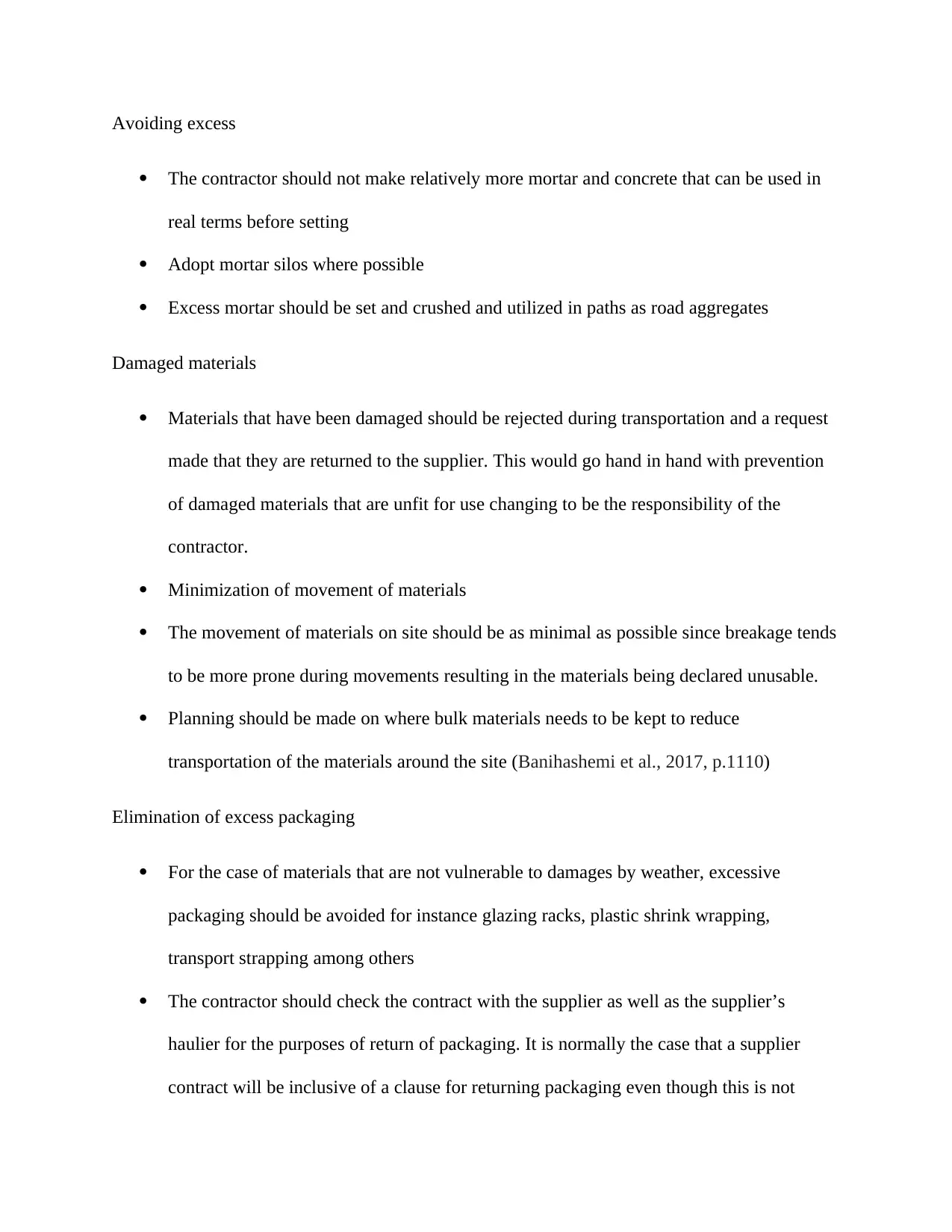
Avoiding excess
The contractor should not make relatively more mortar and concrete that can be used in
real terms before setting
Adopt mortar silos where possible
Excess mortar should be set and crushed and utilized in paths as road aggregates
Damaged materials
Materials that have been damaged should be rejected during transportation and a request
made that they are returned to the supplier. This would go hand in hand with prevention
of damaged materials that are unfit for use changing to be the responsibility of the
contractor.
Minimization of movement of materials
The movement of materials on site should be as minimal as possible since breakage tends
to be more prone during movements resulting in the materials being declared unusable.
Planning should be made on where bulk materials needs to be kept to reduce
transportation of the materials around the site (Banihashemi et al., 2017, p.1110)
Elimination of excess packaging
For the case of materials that are not vulnerable to damages by weather, excessive
packaging should be avoided for instance glazing racks, plastic shrink wrapping,
transport strapping among others
The contractor should check the contract with the supplier as well as the supplier’s
haulier for the purposes of return of packaging. It is normally the case that a supplier
contract will be inclusive of a clause for returning packaging even though this is not
The contractor should not make relatively more mortar and concrete that can be used in
real terms before setting
Adopt mortar silos where possible
Excess mortar should be set and crushed and utilized in paths as road aggregates
Damaged materials
Materials that have been damaged should be rejected during transportation and a request
made that they are returned to the supplier. This would go hand in hand with prevention
of damaged materials that are unfit for use changing to be the responsibility of the
contractor.
Minimization of movement of materials
The movement of materials on site should be as minimal as possible since breakage tends
to be more prone during movements resulting in the materials being declared unusable.
Planning should be made on where bulk materials needs to be kept to reduce
transportation of the materials around the site (Banihashemi et al., 2017, p.1110)
Elimination of excess packaging
For the case of materials that are not vulnerable to damages by weather, excessive
packaging should be avoided for instance glazing racks, plastic shrink wrapping,
transport strapping among others
The contractor should check the contract with the supplier as well as the supplier’s
haulier for the purposes of return of packaging. It is normally the case that a supplier
contract will be inclusive of a clause for returning packaging even though this is not

incorporated in the contract that is made with the haulier. Such issues ought to be
identified and fully resolved early enough to evade chances of any problems on site.
identified and fully resolved early enough to evade chances of any problems on site.
⊘ This is a preview!⊘
Do you want full access?
Subscribe today to unlock all pages.

Trusted by 1+ million students worldwide
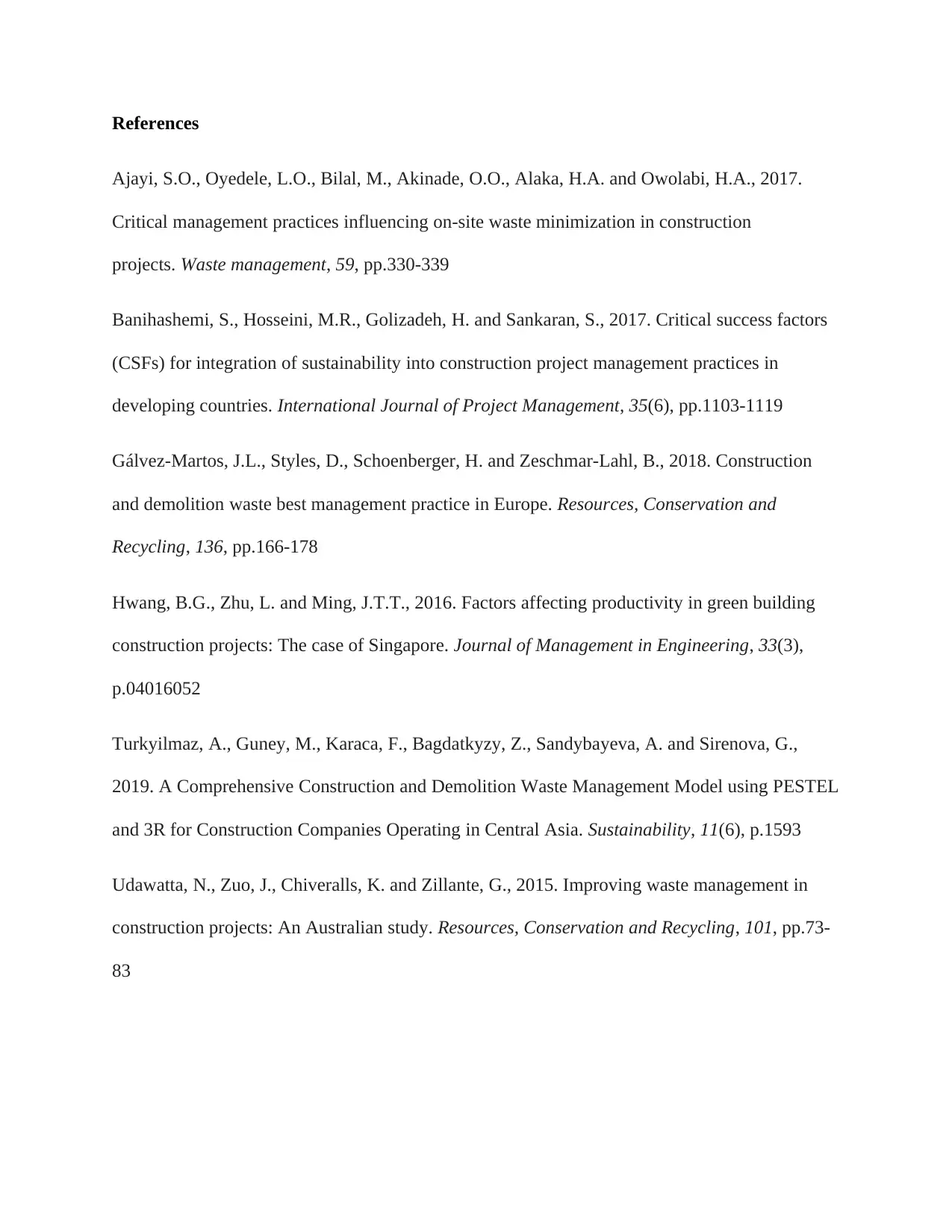
References
Ajayi, S.O., Oyedele, L.O., Bilal, M., Akinade, O.O., Alaka, H.A. and Owolabi, H.A., 2017.
Critical management practices influencing on-site waste minimization in construction
projects. Waste management, 59, pp.330-339
Banihashemi, S., Hosseini, M.R., Golizadeh, H. and Sankaran, S., 2017. Critical success factors
(CSFs) for integration of sustainability into construction project management practices in
developing countries. International Journal of Project Management, 35(6), pp.1103-1119
Gálvez-Martos, J.L., Styles, D., Schoenberger, H. and Zeschmar-Lahl, B., 2018. Construction
and demolition waste best management practice in Europe. Resources, Conservation and
Recycling, 136, pp.166-178
Hwang, B.G., Zhu, L. and Ming, J.T.T., 2016. Factors affecting productivity in green building
construction projects: The case of Singapore. Journal of Management in Engineering, 33(3),
p.04016052
Turkyilmaz, A., Guney, M., Karaca, F., Bagdatkyzy, Z., Sandybayeva, A. and Sirenova, G.,
2019. A Comprehensive Construction and Demolition Waste Management Model using PESTEL
and 3R for Construction Companies Operating in Central Asia. Sustainability, 11(6), p.1593
Udawatta, N., Zuo, J., Chiveralls, K. and Zillante, G., 2015. Improving waste management in
construction projects: An Australian study. Resources, Conservation and Recycling, 101, pp.73-
83
Ajayi, S.O., Oyedele, L.O., Bilal, M., Akinade, O.O., Alaka, H.A. and Owolabi, H.A., 2017.
Critical management practices influencing on-site waste minimization in construction
projects. Waste management, 59, pp.330-339
Banihashemi, S., Hosseini, M.R., Golizadeh, H. and Sankaran, S., 2017. Critical success factors
(CSFs) for integration of sustainability into construction project management practices in
developing countries. International Journal of Project Management, 35(6), pp.1103-1119
Gálvez-Martos, J.L., Styles, D., Schoenberger, H. and Zeschmar-Lahl, B., 2018. Construction
and demolition waste best management practice in Europe. Resources, Conservation and
Recycling, 136, pp.166-178
Hwang, B.G., Zhu, L. and Ming, J.T.T., 2016. Factors affecting productivity in green building
construction projects: The case of Singapore. Journal of Management in Engineering, 33(3),
p.04016052
Turkyilmaz, A., Guney, M., Karaca, F., Bagdatkyzy, Z., Sandybayeva, A. and Sirenova, G.,
2019. A Comprehensive Construction and Demolition Waste Management Model using PESTEL
and 3R for Construction Companies Operating in Central Asia. Sustainability, 11(6), p.1593
Udawatta, N., Zuo, J., Chiveralls, K. and Zillante, G., 2015. Improving waste management in
construction projects: An Australian study. Resources, Conservation and Recycling, 101, pp.73-
83
1 out of 7
Your All-in-One AI-Powered Toolkit for Academic Success.
+13062052269
info@desklib.com
Available 24*7 on WhatsApp / Email
![[object Object]](/_next/static/media/star-bottom.7253800d.svg)
Unlock your academic potential
Copyright © 2020–2025 A2Z Services. All Rights Reserved. Developed and managed by ZUCOL.

